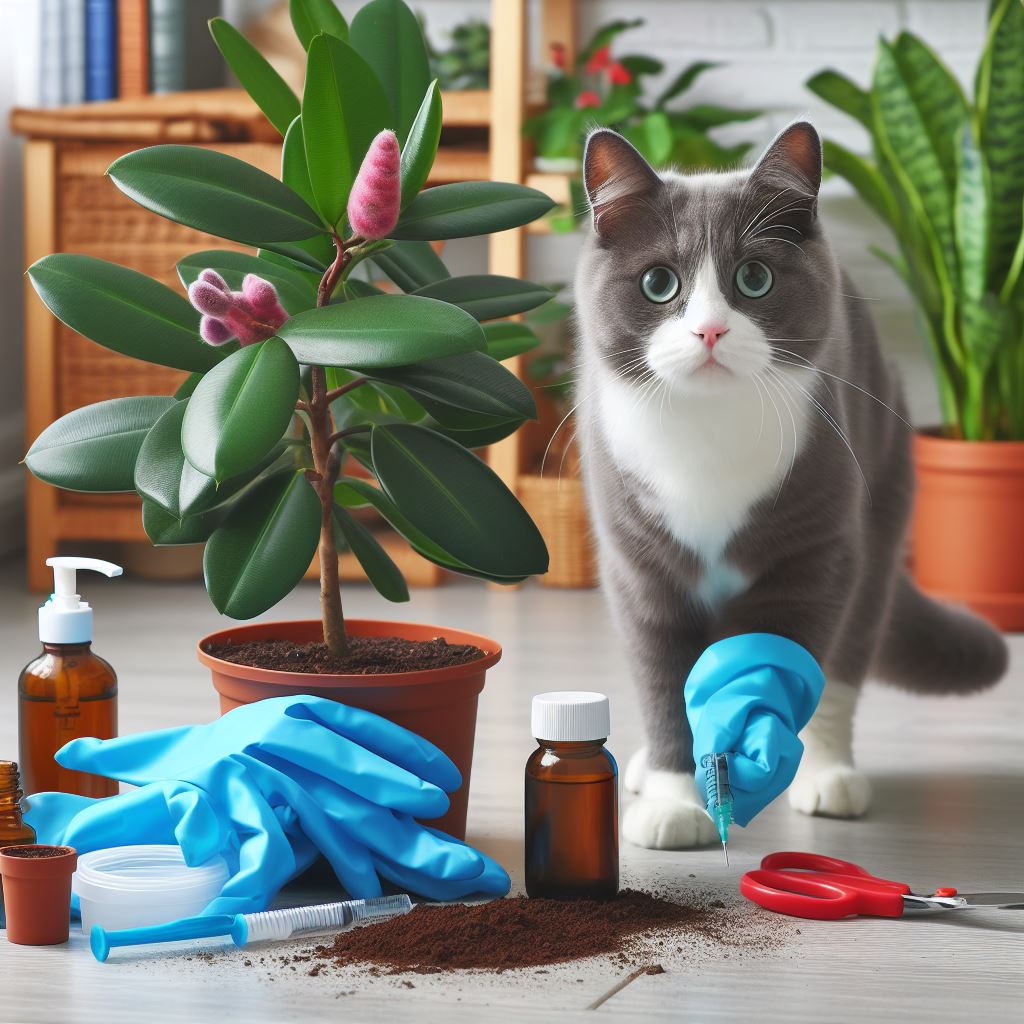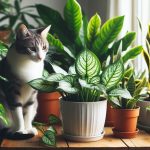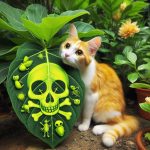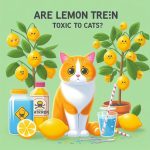Many pet owners wonder, “Are rubber plants toxic to cats?”. It’s important to understand the potential dangers that common household plants may pose to our feline friends. In this blog post, we’ll delve into the topic of cat-proofing your home, with a specific focus on the potential toxicity of rubber plants to cats. From understanding cat behavior to identifying the symptoms of plant ingestion and exploring preventive measures. We’ll equip you with the knowledge to ensure a safe environment for your beloved feline companion. Let’s explore the potential risks and safe alternatives when it comes to rubber plants and your furry friends.
Understanding Cat Behavior
Are Rubber Plants Toxic to Cats?
Understanding your feline friend’s behavior is crucial when it comes to creating a safe and cat-friendly environment at home. Cats are naturally curious and have a tendency to explore their surroundings, including household plants, which may lead to potential health hazards. By comprehending their behavior, you can take the necessary steps to protect them from any harm.
Key Points to Consider:
Curiosity and Exploration: Cats are known for their inquisitive nature, often showing interest in investigating new objects and areas within the home. This behavior may lead them to sniff, chew, or play with household plants, including rubber plants.
Grazing Behavior: Some cats may exhibit grazing behavior, where they nibble on grass or plants as a natural instinct. This behavior could put them at risk of ingesting toxic substances present in certain plants, such as the rubber plant.
Sensitivity to Smells: Cats have a strong sense of smell and may be attracted to the scent of certain plants. This inclination to investigate scents can potentially lead them to interact with plants that are harmful to their health.
Are Rubber Plants Toxic to Cats?
By recognizing these behavioral traits. Pet owners can take proactive measures to ensure the safety of their cats within the home environment. Understanding cat behavior is the first step in implementing effective strategies to safeguard your beloved pet from potential plant toxicity, including the risks associated with rubber plants.

Remember, a well-informed approach to cat behavior and plant toxicity can contribute to a secure and thriving environment for both you and your feline companion.
By being aware and knowledgeable about your cat’s behavior, you can create a safer environment for your pet.
Common Household Plants Toxic to Cats
When creating a safe environment for your feline friend, it’s crucial to be aware of common household plants that can be toxic to cats. Understanding which plants to avoid can help prevent accidental ingestion and potential health issues for your pet. In the case of the focus keyword “are rubber plants toxic to cats”, it’s important to note that rubber plants (Ficus elastica) are indeed toxic to cats if ingested.
Here are some other common household plants that are toxic to cats:
- Lilies: Lilies, especially Easter lilies, are extremely toxic to cats and can lead to kidney failure even with minor ingestion.
- Aloe Vera: While Aloe Vera is known for its medicinal properties, it can cause vomiting and diarrhea in cats when ingested.
- Sago Palm: This popular ornamental plant contains toxins that can cause liver failure in cats.
- Dieffenbachia: Also known as dumb cane, this plant contains oxalate crystals that can cause intense burning and irritation of the mouth, tongue, and lips.
- Jade Plant: Jade plants, also known as rubber plants, can cause vomiting, depression, and incoordination in cats.
It’s crucial to carefully research the plants in your home and garden to ensure they are safe for your feline companion. Taking proactive measures to eliminate toxic plants from your living space can significantly reduce the risk of plant poisoning in cats.
Rubber Plant Toxicity to Cats
Rubber plants, scientifically known as Ficus elastica, are a popular choice for indoor greenery. However, it’s essential for cat owners to be aware of the potential risks these plants pose to their feline friends.
Understanding the Risks
- Toxic Compounds: Rubber plants contain a toxic, milky white sap known as latex, which can be harmful to cats if ingested.
- Effects on Cats: When cats come into contact with the sap or consume any part of the rubber plant, it can lead to symptoms of toxicity.

Symptoms of Poisoning
If you’re wondering, “Are rubber plants toxic to cats?” it’s important to recognize the potential symptoms of ingestion:
- Gastrointestinal Distress: Vomiting, diarrhea, and drooling
- Dermatological Reactions: Irritation or redness around the mouth and skin
- Internal Issues: Potential damage to the cat’s internal organs if large quantities are ingested
Comparison with Other Plants
| Plant | Toxicity to Cats |
|---|---|
| Rubber Plant | Contains toxic latex sap |
| Spider Plant | Non-toxic, safe for cats to be around |
| Aloe Vera | Mild toxicity, can cause gastrointestinal issues |
Understanding the potential risks and symptoms of rubber plant toxicity in cats. is crucial for creating a safe living environment for your pets. In the next section, we’ll explore preventive measures to ensure the well-being of your feline companions.
Symptoms of Rubber Plant Ingestion in Cats
Are Rubber Plants Toxic to Cats?
If you’re concerned about the potential toxicity of rubber plants to your feline friend, it’s important to be aware of the symptoms of ingestion. Keep an eye out for the following signs that may indicate your cat has ingested part of a rubber plant:
- Gastrointestinal Distress: Vomiting, diarrhea, and drooling are common symptoms of plant ingestion in cats.
- Behavioral Changes: Lethargy, depression, and unusual restlessness can be indicators of plant toxicity.
- Loss of Appetite: If your cat suddenly loses interest in food, it could be a red flag.
- Dermatological Reactions: Skin irritation, redness, or inflammation may occur in some cases.
- Difficulty Breathing: Labored breathing and coughing may indicate a severe reaction.
Additionally, it’s essential to keep an eye on your cat’s overall well-being and behavior. If you notice any of these symptoms and suspect that your cat has ingested a rubber plant, it’s crucial to seek veterinary assistance promptly.
Remember, early detection and intervention are crucial in ensuring the well-being of your pet. If you observe any of these signs or have reason to suspect that your cat has ingested a rubber plant, contact your veterinarian immediately for guidance and care.
Preventive Measures for Cat-Proofing Your Home
When it comes to ensuring the safety of your feline companion, taking preventive measures to cat-proof your home is essential. Here are some effective ways to create a safe environment for your cat and prevent potential hazards, such as rubber plant toxicity:

Choose Safe Plants: Opt for cat-friendly plants that are non-toxic to cats. Research and select indoor greenery that will not pose a risk to your curious pet. Look for alternatives to rubber plants, ensuring that they are not harmful if ingested.
Placement: Position potentially toxic plants, including rubber plants, in areas that are inaccessible to your cat. Elevated shelves, hanging planters, or dedicated plant rooms can help prevent your cat from coming into contact with hazardous foliage.
Supervision: Keep an eye on your cat and observe its behavior around plants. Redirecting your cat’s attention with toys and interactive play can help minimize their curiosity about the plants in your home.
Deterrents: Use natural deterrents, such as citrus sprays or natural odor barriers, to discourage your cat from approaching and nibbling on plants that may be toxic to them.
By implementing these preventive measures, you can significantly reduce the risk of plant toxicity for your cat. Remember, creating a safe and secure living space for your cat is crucial for their well-being and health.
Remember, the question “are rubber plants toxic to cats” is a significant concern and taking proactive steps to prevent any potential harm to your furry friend should always be a priority.
Safe Alternatives to Rubber Plants
Are Rubber Plants Toxic to Cats?
When considering cat-proofing your home, it’s essential to provide safe alternatives to potentially toxic plants like rubber plants. Here are some beautiful and feline-friendly alternatives to consider:
Spider Plant: Known for its air-purifying properties, the spider plant is safe for cats and adds an elegant touch to any space.
Bamboo Palm: This non-toxic plant not only looks stylish but also thrives in low light, making it a perfect choice for indoor areas.
Boston Fern: With its lush, green fronds, the Boston fern is a safe option that can also help to add humidity to the air, benefiting both your cat and your home environment.
Areca Palm: This plant not only brings a tropical vibe to your home but is also non-toxic to cats. Providing a safe and visually appealing alternative to rubber plants.
Peperomia: With its unique foliage, the peperomia plant is a non-toxic option that comes in various eye-catching varieties, adding a pop of color to your living space.

These alternatives not only offer a safer environment for your feline friend. but also contribute to the aesthetic appeal of your home. Remember to consider your cat’s behavior and any potential plant hazards when selecting greenery for your living spaces.
Warning Signs of Plant Poisoning in Cats
When it comes to ensuring the safety of your feline friend. Being able to identify the warning signs of plant poisoning is crucial. In the case of rubber plant toxicity. it’s essential to watch out for specific symptoms that may indicate potential poisoning in cats. Here are some warning signs to be mindful of:
Gastrointestinal Distress: Look out for symptoms such as vomiting, diarrhea, and drooling. These are common indicators of plant ingestion and potential toxicity.
Behavioral Changes: Cats may exhibit unusual behavior such as lethargy, loss of appetite, or increased thirst. Pay attention to any significant changes in their usual demeanor.
Physical Symptoms: Keep an eye out for physical signs like pawing at the mouth, oral irritation, or difficulty in breathing. These could be red flags of plant poisoning.
Excessive Salivation: If you notice your cat excessively salivating, it could be a sign of irritation or toxicity caused by ingesting a toxic plant like the rubber plant.

It’s crucial to remember that the manifestation of these symptoms can vary depending on the severity of the toxicity and the amount of the plant ingested. If you observe any of these warning signs or suspect that your cat has ingested a rubber plant. it’s important to act promptly.
By being vigilant and recognizing these warning signs. You can promptly address any potential plant poisoning and seek appropriate care for your cat.
Remember, prevention and awareness are key to creating a safe environment for your beloved feline companion.
Emergency Steps for Suspected Plant Poisoning
If you suspect that your cat has ingested any part of a rubber plant and is showing symptoms of poisoning, it’s crucial to act quickly and seek immediate veterinary attention. Here are some emergency steps to take:
Gather Information:
- Note down the time when you noticed the symptoms and any details about the plant your cat may have ingested.
- If possible, take a sample or photo of the plant for easier identification by the veterinarian.
Contact Your Veterinarian:
- Call your veterinarian or the nearest emergency veterinary clinic. Describe the situation and follow their advice immediately.
Observe Your Cat:
- Monitor your cat’s symptoms closely and provide any first aid recommended by the veterinarian while preparing to transport your cat to the clinic.
Transport Your Cat Safely:
- Carefully transport your cat to the veterinary clinic, ensuring a secure and comfortable journey.
Do Not Induce Vomiting:
- Refrain from inducing vomiting in your cat unless specifically advised by the veterinarian, as some plant toxins can cause more harm when brought back up.
Be Prepared for Treatment:
- Upon reaching the veterinary clinic, be prepared to provide information about the plant, your cat’s symptoms, and any first aid measures you may have administered.

Remember, immediate professional care is vital in cases of suspected plant poisoning. including ingestion of potentially toxic plants like rubber plants. Acting promptly can make a significant difference in your cat’s prognosis and recovery.
By following these emergency steps, you can ensure that your feline companion receives the necessary care and attention during a critical situation involving plant toxicity.
Remember, in emergency situations. it’s always best to follow the guidance of a qualified veterinarian for the safety and well-being of your beloved pet.
Consulting a Veterinarian for Plant Toxicity Concerns – Are Rubber Plants Toxic to Cats?
If you suspect that your cat has ingested a rubber plant and are observing any concerning symptoms. it’s imperative to seek professional veterinary assistance promptly. Here’s why consulting a veterinarian for plant toxicity concerns is crucial:

Expert Guidance: Veterinarians are well-equipped to provide accurate and reliable information regarding the toxicity of rubber plants to cats. They can offer specific advice based on your cat’s health status and the extent of plant ingestion.
Symptom Evaluation: A veterinarian will be able to assess any symptoms your cat. may be experiencing after ingesting a rubber plant. This evaluation is essential for determining the severity of the situation and administering appropriate treatment.
Treatment Recommendations: Should plant toxicity be confirmed, your veterinarian will recommend the necessary treatment options for your cat. This may include inducing vomiting, administering activated charcoal, or providing supportive care to alleviate symptoms.
Preventive Measures: Alongside treatment, veterinarians can offer valuable insights into preventing future plant-related incidents. They may suggest alternative pet-safe plants for your home and provide guidance on creating a feline-friendly environment.
Monitoring and Follow-Up: After initial treatment, veterinarians will monitor your cat’s progress and may recommend follow-up appointments to ensure complete recovery and address any lingering concerns.
Remember, swift action and professional guidance are paramount when dealing with suspected plant toxicity in cats. Consulting a veterinarian promptly can make a significant difference in ensuring your feline companion’s well-being.
Conclusion: Ensuring a Safe Environment for Your Feline Companion
In conclusion, when it comes to creating a safe environment for your feline companion. it is crucial to be mindful of the plants and greenery within your home. Understanding whether common household plants like rubber plants are toxic to cats is a vital aspect of responsible pet ownership.
By being aware of the potential dangers and taking proactive measures. such as opting for safe alternatives to toxic plants. You can significantly reduce the risk of plant poisoning in your cat. Educating yourself about the symptoms of rubber plant ingestion in cats. Being vigilant for warning signs of plant poisoning will also help in early detection and intervention.
If you suspect that your cat has ingested or come into contact with a toxic plant like a rubber plant. it is essential to act promptly. Immediate consultation with a veterinarian and following their guidance for emergency steps can be life-saving for your furry friend.
Ultimately, ensuring a safe environment for your feline companion involves a combination of preventive measures. Quick intervention in case of emergencie. and seeking professional veterinary advice. With these steps in place. You can create a home that is both enriching. Safe for your beloved cat. allowing them to thrive in a secure and pet-friendly setting.

Frequently Asked Questions
Are rubber plants toxic to cats?
Yes, rubber plants are toxic to cats. They contain a toxic sap that can cause vomiting, skin irritation, and other symptoms in cats if ingested. It’s important to keep rubber plants out of reach of cats to ensure their safety.
What are the symptoms of rubber plant poisoning in cats?
The symptoms of rubber plant poisoning in cats include vomiting, drooling, lack of appetite. Sensitive or irritated skin, and in severe cases, difficulty breathing. If you suspect your cat has ingested a rubber plant, seek immediate veterinary care.
How can I cat-proof my home against rubber plants?
To cat-proof your home against rubber plants, consider placing them in areas that are completely inaccessible to your cat. Such as high shelves or rooms that are off-limits to your cat. You can also opt for cat-friendly plants and keep toxic plants securely behind closed doors or in hanging containers.
What should I do if my cat ingests a rubber plant?
If you suspect your cat has ingested a rubber plant, contact your veterinarian immediately. Do not wait for symptoms to appear before seeking help. It’s important to act quickly to minimize the potential harm to your cat.
Are there alternative cat-friendly plants to rubber plants?
Yes, there are several cat-friendly plants that you can consider, such as Boston ferns, spider plants, and catnip. These plants are non-toxic to cats and can be a safe and enjoyable addition to your home. Always research the toxicity of plants before introducing them to your home.
Certainly, here’s a more detailed list of commonly known rubber plants and their toxicity to cats:
| Plant Name | Scientific Name | Toxic to Cats? | Toxic Components | Symptoms in Cats | Notes |
|---|---|---|---|---|---|
| Rubber Plant | Ficus elastica | Yes | Ficin (proteolytic enzyme), latex | Vomiting, drooling, oral irritation, difficulty swallowing | All parts of the plant, including the sap, can be toxic. Keep out of reach of cats. |
| Fiddle Leaf Fig | Ficus lyrata | Yes | Ficin (proteolytic enzyme), latex | Vomiting, drooling, oral irritation, difficulty swallowing | All parts of the plant, including the sap, can be toxic. Keep out of reach of cats. |
| Weeping Fig | Ficus benjamina | Yes | Ficin (proteolytic enzyme), latex | Vomiting, drooling, oral irritation, difficulty swallowing | All parts of the plant, including the sap, can be toxic. Keep out of reach of cats. |
| Plant Name | Toxic to Cats |
|---|---|
| Ficus elastica | Yes |
| Ficus lyrata (Fiddle Leaf Fig) | Yes |
| Ficus benjamina (Weeping Fig) | Yes |
It’s crucial to note that the toxicity of these plants can vary, and individual cats may react differently. If you suspect your cat has ingested any part of a rubber plant and is showing signs of distress, it is recommended to contact your veterinarian immediately. Additionally, some cats may show sensitivity even to non-toxic plants, so it’s always a good idea to monitor your pet’s behavior around houseplants.
Unveiling the Truth: Is Swedish Ivy Toxic to Cats?
Read More Now..






